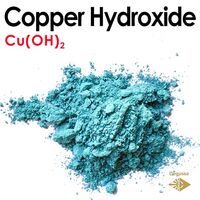Lead Acetate - Lead(II) acetate trihydrate - chemical compound
Pb(C2H3O2)2·3H2O
Lead(II) acetate (Pb(CH3COO)2), also known as lead acetate is a white crystalline chemical compound with a slightly sweet taste. Lead acetate is soluble in water and glycerin. With water, it forms the trihydrate, Pb(CH3COO)2·3H2O, a colourless or white efflorescent monoclinic crystalline substance. The substance is used as a reagent to make other lead compounds and as a fixative for some dyes. In low concentrations, it is the principal active ingredient in progressive types of hair colouring dyes. Lead(II) acetate is also used as a mordant in textile printing and dyeing, and as a drier in paints and varnishes. It was historically used as a sweetener and preservative in wines and in other foods and for cosmetics.
The ancient Romans, who had few sweeteners besides honey, would boil must (grape juice) in lead pots to produce a reduced sugar syrup called defrutum, concentrated again into sapa. This syrup was used to sweeten wine and to sweeten and preserve fruit. It is possible that lead(II) acetate or other lead compounds leaching into the syrup might have caused lead poisoning in those who consumed it.
It was still used in the USA in men's hair colouring products like Grecian Formula.
Medical uses
Lead(II) acetate solution was a commonly used folk remedy for sore nipples. In modern medicine, for a time, it was used as an astringent, in the form of Goulard's Extract, and it has also been used to treat poison ivy.
Industrial uses
Lead(II) acetate paper is used to detect the poisonous gas hydrogen sulfide. The gas reacts with lead(II) acetate on the moistened test paper to form a grey precipitate of lead(II) sulfide. An aqueous solution of lead(II) acetate is the byproduct of a 1:1 ratio of hydrogen peroxide and white vinegar (acetic acid) used in the cleaning and maintenance of stainless steel firearm suppressors (silencers) and compensators. The solution is agitated by the bubbling action of the hydrogen peroxide, and the main reaction is the dissolution of lead deposits within the suppressor by the acetic acid, which forms lead acetate. Because of its high toxicity, this chemical solution must be appropriately disposed by a chemical processing facility or hazardous materials centre. Alternatively, the solution may be reacted with sulfuric acid to precipitate nearly insoluble lead(II) sulfate. The solid may then be removed by mechanical filtration and is safer to dispose of than aqueous lead acetate.
Saturn's Tree
Diana's Tree (Latin: Arbor Diana or Dianae), also known as the Philosopher's Tree (Arbor Philosophorum), was considered a precursor to the Philosopher’s Stone and resembled coral in regards to its structure. It is a dendritic amalgam of crystallized silver, obtained from mercury in a solution of silver nitrate; so-called by the alchemists, among whom "Diana" stood for silver. The arborescence of this amalgam, which even included fruit-like forms on its branches, led pre-modern chemical philosophers to theorize the existence of life in the kingdom of minerals.
More about Lead Acetate in Wikipedia
Formula: Pb(C2H3O2)2·3H2O
Molar mass: 379.33 g/mol g/mol
Form: white efflorescent monoclinic crystalline substance
CAS Number: 6080-56-4
Density: 2.55 g/cm³
Synonyms: lead diacetate, plumbous acetate, sugar of lead, lead sugar, salt of Saturn, or Goulard's powder, Acetate de plomb, Bleiacetat, Plumbous acetate
Lead Acetate - Lead(II) acetate trihydrate - chemical compound
- Brand: Degussa
- Product Code: Oxide - Lead acetate - Pb(C2H3O2)2
- SKU: Pb(C2H3O2)2
- Availability: 256
-
0.99€
Available Options
Related Products
Lead Monoxide - Yellow Pigment for effect glazes
PbO Lead(II) oxide, also called lead monoxide, is the inorganic compound with the molecular formula PbO. PbO occurs..
0.99€
Copper Hydroxide - Cupric hydroxide patina for ceramics - cuoh
Cu(OH)2 Copper(II) hydroxide is the hydroxide of copper with the chemical formula of Cu(OH)2. It is a pale greenish..
0.99€
Potassium metabisulfite
K2S2O5 Potassium metabisulfite, K2S2O5, also known as potassium pyrosulfite, is a white crystalline powder with a p..
0.99€
Potassium ferricyanide - Prussian Red, Potassium hexacyanoferrate(III)
K3[Fe(CN)6] Potassium ferricyanide is a chemical compound. This bright red salt is soluble in water and its solutio..
1.19€
Tags: oxides










